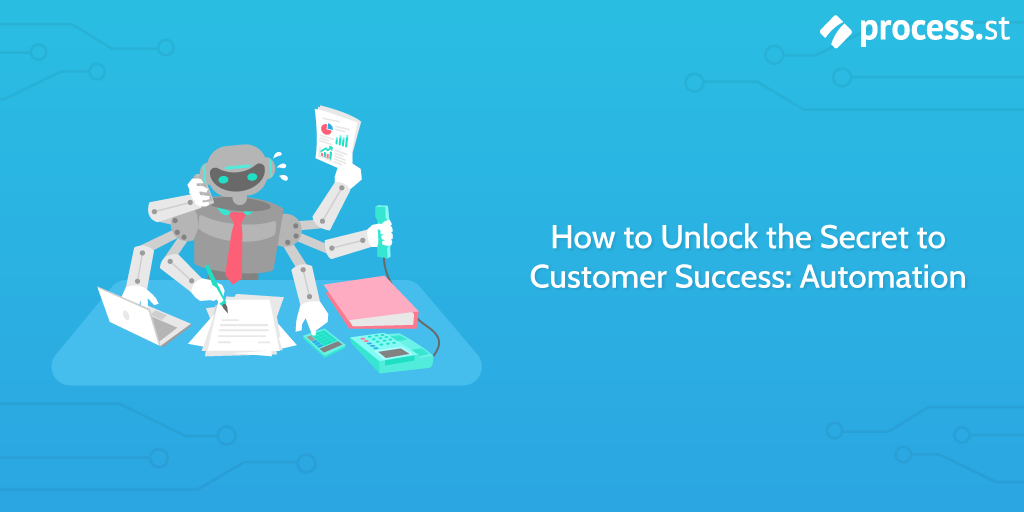 This is a guest post from Shawn Mike. Shawn has been working with writing challenging clients for over five years. His educational background in the technical field and business studies has given him the edge to write on many topics. He occasionally writes blog articles for Dynamologic Solutions.
This is a guest post from Shawn Mike. Shawn has been working with writing challenging clients for over five years. His educational background in the technical field and business studies has given him the edge to write on many topics. He occasionally writes blog articles for Dynamologic Solutions.
According to statistics, it is claimed that US organizations suffer a loss of $62 billion a year thanks to unsatisfactory customer service.
Customer service represents your secondary acquisition test, beyond actually getting that customer on board in the first place.
It’s very much a short-term game of conflict resolution, and your business depends mainly on how you deal with customer feedback and requests.
For maximum lifetime value, you need to consider how to synergize customer service with customer success.
It must be kept in mind that customers are the heart of every business and should be at the top of your priority list.
Satisfied customers help increase sales and build brand identity and reports claim that 77% of customers are estimated to recommend a brand or business to a friend depending on how good their experience with your product is.
Which is why focusing on keeping your customer base satisfied with great service and excellent products can go a long way in improving your sales.
Nowadays, consumers expect more than just a great product. They need you to guide them through the perfect experience. A better customer experience equals a greater lifetime value expectancy.
This article is all about figuring out the best way to analyze and improve customer experience by automating a lot of the manual work that can get in the way.
We’ll focus on:
- Understanding customer success
- Difference between customer service and customer success
- How to improve your customer success strategy
- Benefits of customer success automation
- How to successfully automate customer success
- Example customer success process template
Read on to learn more about how to optimize your customer success strategy. There’s even a free Ebook for you at the end of it!
What is customer success?
Customer success is a way of thinking and strategizing about solving customer problems in a proactive, preventative way. It’s the idea that you need to recognize that your customers have specific goals they are trying to achieve with your product, and it’s your job to help them achieve those goals.
To understand customer success, you have to understand what success looks like for your customers. This is different for each customer, just like the method for achieving success.
If your customers aren’t constantly getting value from what they’re paying you, it’s not hard to see why they will want to stop being your customer.
Customer service vs customer success
Customer success is often lumped in together with customer service. Sometimes it’s described as the “proactive” way of doing customer service, and implies that customer service is mostly reactive.
The truth is, customer service can be both proactive and reactive, while customer success tends to be mostly proactive. Both are important.
It’s a bit like the difference between proactive risk management and reactive “firefighting” when it comes to dealing with risks in a business. You need ways to prevent risks from happening, as well as ways to deal with the risk when they materialize.
Fundamentally, customer success is more about a long-term strategy, whereas customer service can be understood as a shorter-term investment.
When it comes to customer service, first impressions matter. Studies show that over 51% of customers choose not to return to a company after a negative customer service experience.
Customer success, on the other hand, is more focused on building relationships in order to create value by working with the customer to improve their business.
There are some big differences but ultimately customer success and customer service have to work together.
How to improve your customer success strategy
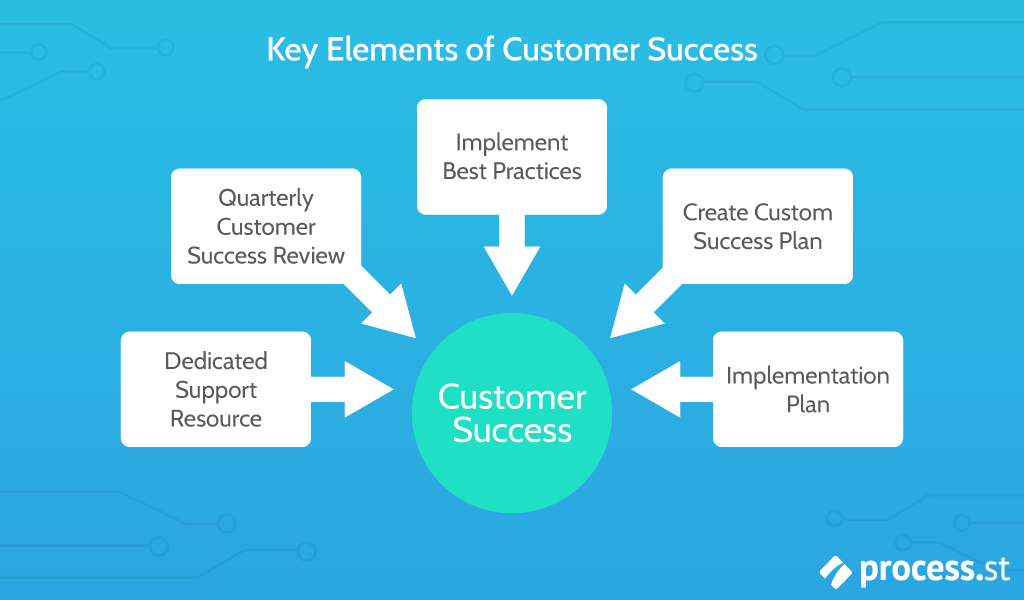 Here are some stratagems that can help enhance your standards of customer success.
Here are some stratagems that can help enhance your standards of customer success.
Have a process in place
Technology has made it easy for customers to reach out to their favorite brands and companies, and for brands to reciprocate that interaction.
When it comes to your customers, this means they will expect a direct line of access to your team, should they have any queries.
It’s important to waste no time in responding, and part of that is making it as easy as possible for your customers to reach you. Highlight relevant channels and make sure these channels have baked-in processes to deal with customer requests and feedback.
This ensures as little time as possible is wasted and leaves a positive impression about your brand, while promoting trust.
For example, you might use a customer feedback checklist to record customer feedback and gain insight into their thought process.
Product knowledge is a tool – use it
A professional customer representative will have deep knowledge and understanding of all the amenities offered by your business and how they work.
Clients often have a variety of questions and queries that need to be answered and if your team is not familiar with your products, how can you expect to help your customers utilize those products to succeed at anything?
Make sure all team members are adequately trained and clued up on all relevant product knowledge.
Have your customer success team use the product, build processes that incorporate the product, and involve them in discussions of product improvements to cultivate a sense of product ownership and responsibility.
Understand how to use BPM for customer success
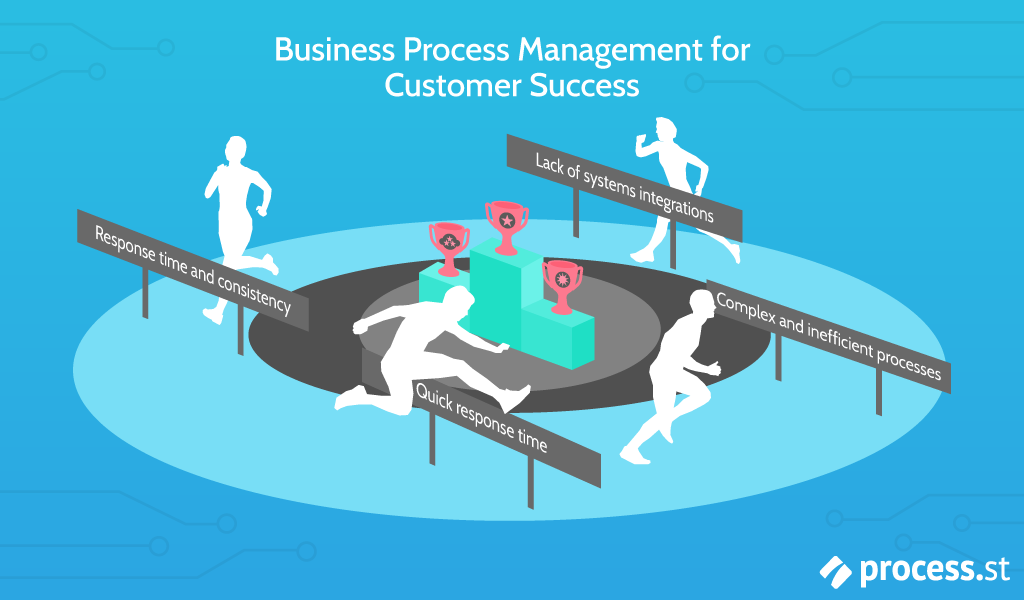 BPM, or business process management, is the principle of looking at your business in terms of the processes that you use every day, and trying to optimize those processes to achieve your goals.
BPM, or business process management, is the principle of looking at your business in terms of the processes that you use every day, and trying to optimize those processes to achieve your goals.
In terms of customer success, it means making sure you have good processes for all things customer service & customer success.
It also means taking a continuous improvement approach, with the intention to constantly look for areas of improvement for all of your business processes.
BPM involves looking for ways to automate and save time by using BPM software like Process Street to eliminate tedious manual tasks for you.
Building a strong customer success team
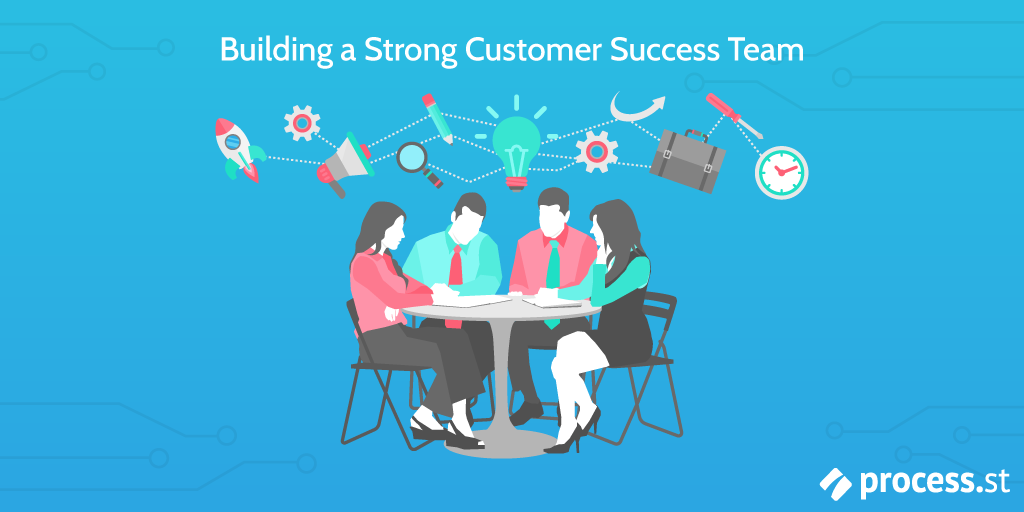 There is always room for improvement within the team and developing a strong and skilled team to handle all customer-related demands is crucial.
There is always room for improvement within the team and developing a strong and skilled team to handle all customer-related demands is crucial.
It is important to recruit individuals with the right skills such as admirable communication skills, patience and empathy, and knowledge about the product or service your business is offering.
All these qualities paired with adequate training will provide you with a strong set of customer representatives that can take on the daily challenges thrown their way.
You should also be tracking your team’s performance via customer feedback. Have customers rate and comment on the representative handling their case and you’ll be able to learn more about their success rates.
Insights from ratings and reviews can assist you in judging the performance of each customer service representative fairly, and provide guidance and training wherever improvement is required.
Understand when to automate customer success
Consider the processes you use to deal with your customers.
Perhaps you have processes for taking your customers from discovery to their “Aha! Moment”, or a process for the hand-off between sales and customer success departments.
Whatever process you use, you should remember:
- Part of this process can be automated
- You can break down the process into clear, distinct steps
- You can train a group of people to reliably and repetitively execute the process
- You can track and document the process
So, when is the best time to automate customer success?
Certain steps of the onboarding process can and should be automated. These are things that don’t rely on a deep level of complex human interaction, like the sending of welcome emails and surveys, for example.
Other things make less sense to automate, like customer service tasks. Often it’s about finding a balance between automation (i.e. being notified automatically that a user has a query, and then using a template response to speed up the resolution) and manual work (individually tailoring a response to a specific individual, and taking the time to understand their situation).
What are the benefits of customer success automation?
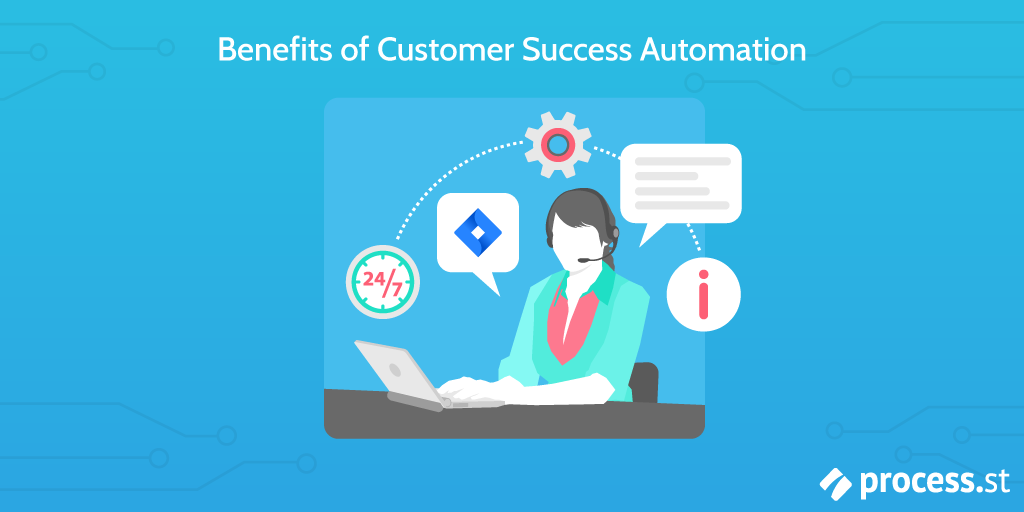
Lowers costs
In an expanding business, there is a constant requirement for skilled customer support and success staff, which poses the problem of high costs and slow hiring processes.
Automating your customer success solutions offers you the benefit of handling common, straightforward tasks without expending resources on repeating the same process over and over.
For example, you could use an employee onboarding checklist to automate a lot of the tasks involved with a new hire; the same can be applied to any client onboarding process.
By incorporating automation into these processes, you can also save money by hiring a less skilled VA to perform a more complex process by following a checklist.
Customers spend less time waiting around
The longer you take to respond to a customer, the angrier they will get.
Automation means you get to the customer as fast as possible. Immediate solutions with minimal waiting time.
The most common questions can be responded to within minutes and sometimes they are just struggling with navigation so prompt replies prevents a potential customer from jumping ship.
Whatever their need, both active and reactive solutions benefit from automation by reducing waiting times for your customers.
No room for human error
The foremost benefit of automation is that minimizes or eliminates human error.
Often, when there is too much workload or responsibilities on one or two support agents, it leads to exhaustion and major blunders.
However, automation rids you of such instances and speeds up processes without requiring any manpower.
Allows customer service agents to focus on other areas
Staff members that used to spend hours daily typing the same email and message responses can rely on automated chatbots to handle those tasks. This allows them to focus their attention on other significant areas in customer service to provide a superior experience.
Support agents must be aware of how customers interact with the products and support funnel to improve customer retention.
Today, the purpose of AI, chatbots and similar automation is not to control everything in customer service sectors but to handle a selection of areas so the workflow is organized and smooth-sailing.
Furthermore, Forbes predicts that by 2020, 86% of all customer service interactions will be dealt with by automated customer service systems.
Managing simple and recurring tasks like answering questions, directing customers to the right services, taking complaints and responding to emails, automation can make the lives of customer service representatives less hectic.
This is especially beneficial for startups with limited funds or sluggish recruitment. Customer service automation allows you to run efficiently and compellingly with a reduced number of team members.
How to automate customer success
Automating customer success depends on understanding what success means for each customer.
This isn’t something that can be automated – but it is a process. And by thinking of customer success as a process, we can look for ways to automate manual tasks along the way.
Give your users the option to self-serve
Research shows that a majority of customers prefer to handle their problems on their own and turn to customer service as a last measure.
Setting up a FAQ page or a chatbot is one of the most effective ways to offer quick customer service. This could include some of the most common topics and frequently asked questions that customers seek answers to.
Customers can easily search this knowledge base and look for solutions regarding your product or service faster. It’s a stress-free way of delivering unwavering support and quality service while also reducing the ticket accumulation on your helpdesk.
For instance, if your business provides mobile and web app development services customer should easily be able to navigate the FAQ widget on your site. Triggering a chatbot that immediately directs them to your services or offers assistance on any of their queries will keep the customer returning for future help.
Also, language barriers can often cause problems for customers in conveying their needs. Programming your bot to be multilingual allows them to interact freely with your knowledge base and help them get an instant response to all their queries.
Use BPM software to automate manual tasks
You can use a BPM software like Process Street to automate manual tasks and improve your customer success process.
Check out this video webinar for a quick-start guide, from Blake Bailey of Process Street’s own customer success:
24/7 availability
One of the ways automation benefits a business is that customer service is not restricted to business hours only.
Customers can ask questions, create tickets and send messages at any time, even on national or worldwide holidays. Instant replies save customers a great deal of frustration and reduce any occurrence of friction between them and support agents.
In this way, you can form a solid base of customer satisfaction from which to build atop long-term strategies of customer success. When your team can’t be available 24/7 for in-depth one-on-one problem solving and strategizing, automated responses are a kind of cushion that helps mitigate dissatisfaction.
Template responses and FAQ sections can work wonders, when utilized appropriately.
Automate responses to behavioral data
Monitoring the behavioral patterns of customers can prove to be particularly advantageous for customer service and success personalization.
If a customer has repeatedly visited a particular page on your website, it means they might be interested in an item but are contemplating making a purchase.
By triggering an automated chat, they can offer assistance or point them in the direction of a FAQ page so they can arrive at a decision.
Also, when a client has viewed a specific product several times, prompting a chatbot to offer them help or guide them to other options can result in huge points earned in customer satisfaction.
Personalizing a customer’s experience shows that you care for and understand where their interest is, which makes their experience all the more worth it.
You can also use this insight to offer them unique and personalized success strategies, and avoid overloading them with data. When you understand their user habits and know how they’ve been using your product, you can approach your customer success strategy in a way that wastes no time in retreading old ground.
Customer success template: DoubleDutch’s process
What better way to understand the customer success process than to take a look at a checklist designed for exactly that.
This template highlights DoubleDutch’s process for customer success, from the kick-off call to follow-up.
What’s your customer success process? How do you automate it, if at all? What are the pros and cons of automating customer success like this? Let us know, we want to hear from you.







 Workflows
Workflows Projects
Projects Data Sets
Data Sets Forms
Forms Pages
Pages Automations
Automations Analytics
Analytics Apps
Apps Integrations
Integrations
 Property management
Property management
 Human resources
Human resources
 Customer management
Customer management
 Information technology
Information technology



Oliver Peterson
Oliver Peterson is a content writer for Process Street with an interest in systems and processes, attempting to use them as tools for taking apart problems and gaining insight into building robust, lasting solutions.